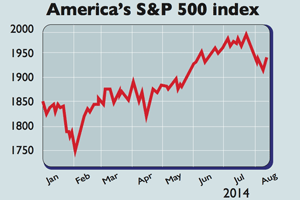
Investors’ “love affair” with shares could be heading for a “nasty break-up”, says the Financial Times. America’s S&P 500 has fallen by 4% from last month’s record high. The pan-European and German markets are down by more than 10% – taking them into official ‘correction’ territory. Is this the end of the post-2009 rally?
The lengthening list of geopolitical problems seems finally to have snapped markets out of their complacency. The worsening crisis in Ukraine, with Russia now slapping tit-for-tat sanctions on food and agricultural products from Europe, has caused the greatest worry.
“The evidence is building that Russian sanctions are starting to hit the [European] economy,” reckons Jim Reid of Deutsche Bank. Russia is the European Union’s third-largest trading partner behind the US and China, accounting for just under 10% of the region’s trade.
But it’s not just global turmoil. “When war trumpets sound, geopolitics beats finance,” says James Mackintosh in the FT. However, “the rest of the time, worry about monetary policy”. Thanks to strong recent data in the US, the first interest-rate rise in America may be closer than investors had expected – and that’s also got them rattled.
Yet the cumulative impact of all these concerns may not be enough to derail the rally, says Fidelity’s Tom Stevenson in The Sunday Telegraph. History shows that rising but low interest rates “don’t need to be a problem for stock markets”. Investors should see higher rates as a sign of confidence in the recovery.
The global economy is still growing slowly but steadily. Improving corporate confidence is reflected in the healthy mergers and acquisitions market. “Bosses will only consider takeovers if optimistic.”
Meanwhile, as Capital Economics points out, more money printing looks likely in Europe and Japan as the European Central Bank tries to prevent deflation, and Japan’s central bank tries to hit its 2% inflation target.
So, even if America picks up, global markets can expect more liquidity from other sources. And if the US takes an unexpected nosedive, there will be more money printing there too.
The pattern of the last 20 years has been that when things get tough, central banks do what they can to prop up markets. This artificial rally looks set to keep gorging on steroids, and if it falters, central bankers will up the dose.